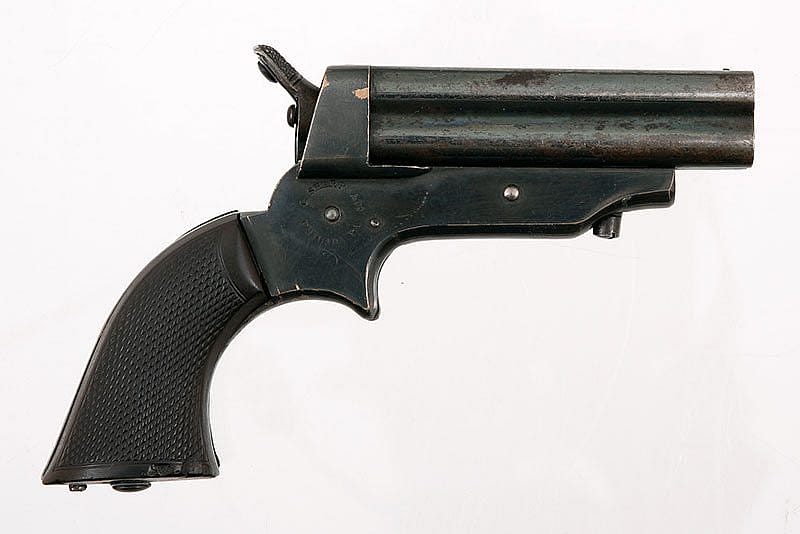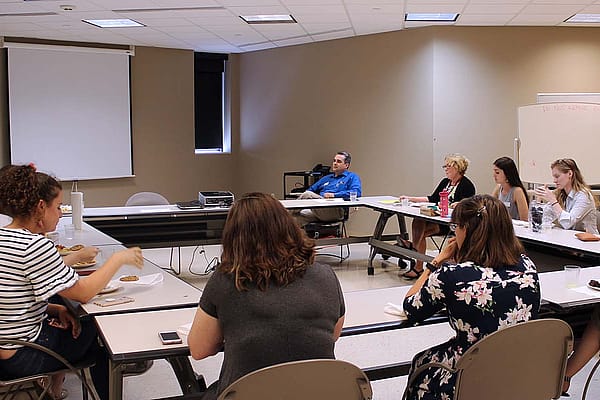
The Journey Continues: More Firearms from the Smithsonian – Points West Online
Originally published in Points West magazine
Summer 2013
The Journey Continues: More Firearms from the Smithsonian
A three-cylinder revolver. Sliding breech chamber. Revolving firearm that uses a chain. A sundial. Two cylinders, a central axis pin, and two triggers. Blunderbuss.
Turkey, Albania, Germany, Japan, North Africa, France, England, and America. As you’ve read in our previous post, Journeying West: Distinctive Firearms from the Smithsonian is a collection of extraordinary and unusual guns, and gun parts from around the world. Read on for more information about additional firearms in this exhibit (indicated by ID numbers that begin with “L”). We’ve also included images from the Center of the West’s Winchester Arms Collection, a gift of the Olin Corporation, indicated by numbers beginning with “1988.”
McClellan’s British Lang Pepperbox Pistol, 1845.
L.373.2012.12
According to American Civil War General George B. McClellan, the Duke of Wellington presented him with this pepperbox.
— ♦ —
North & Cheney Model 1799 Flintlock Pistol First Contract.
L.373.2012.9
The United States government first commissioned this pistol with Simeon North and Elisha Cheney of Berlin, Connecticut, in two separate contracts.
The North & Cheney pistol in the Smithsonian exhibit hung in President Kennedy’s Oval Office. Cody Firearms Museum. 1988.8.249
— ♦ —
Pair of Harpers Ferry Model 1805 Smoothbore Pistols, 1806.
L.373.2012.6 & L.373.2012.7
Only thirty of more than three hundred Model 1805 pistols manufactured at Harpers Ferry bear an “1806” stamp; this makes the firearm extremely rare.
— ♦ —
Belton Fusil Repeating Musket, 1758.
L.373.2012.2
Joseph Belton of Philadelphia, Pennsylvania, developed his .72 caliber fusil repeating musket in 1758. Designed to fire eight musket balls in a row, it acted like a Roman candle as it ignited a fused chain of charged musket balls stacked in a single barrel and packaged in one paper cartridge. While the military initially commissioned one hundred of these muskets, Congress later cancelled the commission because they were too expensive.
— ♦ —
Ellsworth Colt Model 1860 Army Revolver.
L.373.2012.63
Colonel Elmer E. Ellsworth of New York was the first notable casualty of the Civil War and a martyr for the Union cause. He was killed by an innkeeper in Alexandria, Virginia, for lowering a Confederate flag. Private Francis E. Brownell avenged Ellsworth’s death and became one of the first heroes of the Civil War. Brownell donated this Model 1860 Army Revolver to the National Firearms Collection.
— ♦ —
Mighill Nutting Patent, April 25, 1838, Portland, Maine.
L.373.2012.18
This firearm connects two cylinders by a central axis pin and two triggers. Nutting received his patent two years after Colt received his first revolver patent, and Colt wanted to sue Nutting for patent infringement. However, the secretary of the Colt Manufacturing Company advised him against it. Instead, he drove Nutting into obscurity: Colt lowered prices, increased advertising, and publically threatened challengers of Colt’s patents.
— ♦ —
Morse Patent, October 28, 1856, Worchester, Massachusetts.
L.373.2012.45
This patent opens the breech chamber and cocks the weapon simultaneously. Morse claimed that the firearm was sealed so tightly that the weapon could be discharged under water.


— ♦ —
Lord Patent, June 12, 1860, Minersville, Pennsylvania.
L.373.2012.44
James Lord altered a Pennsylvania Kentucky long rifle for this patent. The design includes percussion caps that explode within the barrel, so they can operate in all weather conditions.
— ♦ —
Smith & Wesson Magazine Lever Action Patent February 14, 1854.
L.373.2012.15
Horace Smith’s and Daniel Wesson’s design is the first lever-action type firearm. It was designed to fire metallic rimfire cartridges. This pistol was the grandfather to the lever-action. It was named the volcanic pistol after Smith and Wesson’s Volcanic Repeating Arms Company. They sold the production rights of this company to Oliver Winchester in 1855. Cody Firearms Museum. 1988.8.418
— ♦ —
Harpers Ferry Model 1805 Rifled Flintlock Pistol.
L.373.2012.8
There is only one other rifled Model 1805 pistol known. It is on display at the Jefferson County Museum in West Virginia.
— ♦ —
Sharps Patent, December 18, 1849, Washington, DC.
L.373.2012.25
Christian Sharps’ patent has four stationary barrels and a single revolving hammer that is operated with a lever. Cody Firearms Museum. 1988.8.711a
— ♦ —
Colt Patent, February 25, 1836, Hartford, Connecticut.
L.373.2012.22
This design was the first revolving firearm ever patented. Controversy over a similar patent, issued by B.M. Darling in 1836, plagued this invention. A fire destroyed the original designs of Darling before a full investigation could occur. The Colt’s Patent Fire Arms Manufacturing Company, originally in Paterson, New Jersey, produced rifles and revolvers from this patent. The revolvers would become known as Paterson revolvers. Colt-Paterson No. 3 Belt Revolver, 1838 – 1839. Cody Firearms Museum. 1988.8.962
— ♦ —
Porter Turret Rifle, July 8, 1851, Memphis, Tennessee.
L.373.2012.17
This patent consists of an eight chamber vertical revolving cylinder. A canister magazine that contains the charge and ball is on top of the cylinder. G.P. Foster in Taunton, Massachusetts, created four models from this patent. The early model with canister magazine closely follows the patent. Only two were reported to have been produced. The first and second models had a nine-shot turret, while the third had an eight-shot turret. This is similar to the production models found at the Cody Firearms Museum. A fictitious story surfaced that Porter was killed while demonstrating this model to Samuel Colt. The rumor is that this story was created to make an auction catalog more interesting.
Post 021
Written By
Nancy McClure
Nancy now does Grants & Foundations Relations for the Center of the West's Development Department, but was formerly the Content Producer for the Center's Public Relations Department, where her work included writing and updating website content, publicizing events, copy editing, working with images, and producing the e-newsletter Western Wire. Her current job is seeking and applying for funding from government grants and private foundations. In her spare time, Nancy enjoys photography, reading, flower gardening, and playing the flute.















